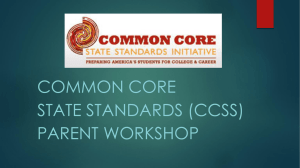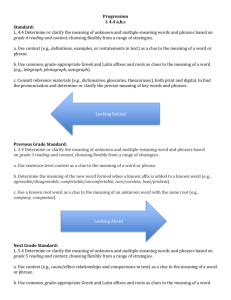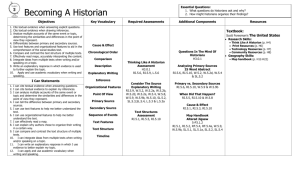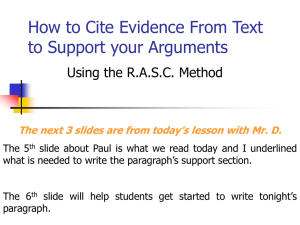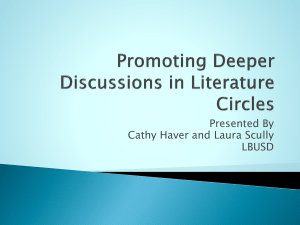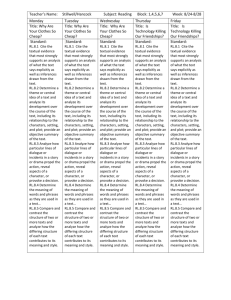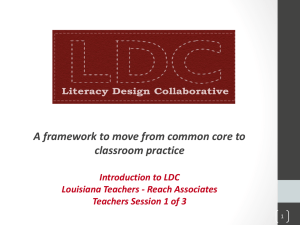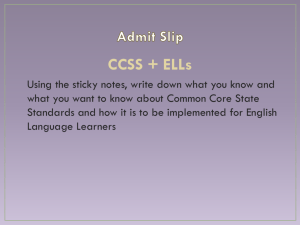MN English Language Arts Content Standard Reading DesCartes
advertisement
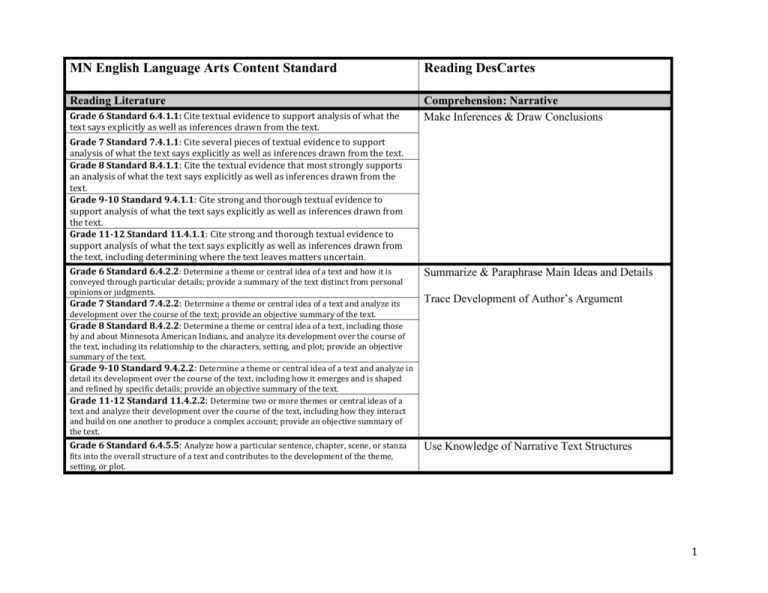
MN English Language Arts Content Standard Reading DesCartes Reading Literature Comprehension: Narrative Make Inferences & Draw Conclusions Grade 6 Standard 6.4.1.1: Cite textual evidence to support analysis of what the text says explicitly as well as inferences drawn from the text. Grade 7 Standard 7.4.1.1: Cite several pieces of textual evidence to support analysis of what the text says explicitly as well as inferences drawn from the text. Grade 8 Standard 8.4.1.1: Cite the textual evidence that most strongly supports an analysis of what the text says explicitly as well as inferences drawn from the text. Grade 9-10 Standard 9.4.1.1: Cite strong and thorough textual evidence to support analysis of what the text says explicitly as well as inferences drawn from the text. Grade 11-12 Standard 11.4.1.1: Cite strong and thorough textual evidence to support analysis of what the text says explicitly as well as inferences drawn from the text, including determining where the text leaves matters uncertain. Grade 6 Standard 6.4.2.2: Determine a theme or central idea of a text and how it is conveyed through particular details; provide a summary of the text distinct from personal opinions or judgments. Grade 7 Standard 7.4.2.2: Determine a theme or central idea of a text and analyze its development over the course of the text; provide an objective summary of the text. Grade 8 Standard 8.4.2.2: Determine a theme or central idea of a text, including those by and about Minnesota American Indians, and analyze its development over the course of the text, including its relationship to the characters, setting, and plot; provide an objective summary of the text. Grade 9-10 Standard 9.4.2.2: Determine a theme or central idea of a text and analyze in detail its development over the course of the text, including how it emerges and is shaped and refined by specific details; provide an objective summary of the text. Grade 11-12 Standard 11.4.2.2: Determine two or more themes or central ideas of a text and analyze their development over the course of the text, including how they interact and build on one another to produce a complex account; provide an objective summary of the text. Grade 6 Standard 6.4.5.5: Analyze how a particular sentence, chapter, scene, or stanza fits into the overall structure of a text and contributes to the development of the theme, setting, or plot. Summarize & Paraphrase Main Ideas and Details Trace Development of Author’s Argument Use Knowledge of Narrative Text Structures 1 MN English Language Arts Content Standard Reading DesCartes Reading: Informational Text Comprehension: Informational Analyze a Variety of Non-Fiction Materials Grade 6 Standard 6.5.1.1: Cite textual evidence to support analysis of what the text says explicitly as well as inferences drawn from the text. Grade 7 Standard 7.5.1.1: Cite several pieces of textual evidence to support analysis of what the text says explicitly as well as inferences drawn from the text. Grade 8 Standard 8.5.1.1: Cite the textual evidence that most strongly supports an analysis of what the text says explicitly as well as inferences drawn from the text. Grade 9-10 Standard 9.5.1.1: Cite strong and thorough textual evidence to support analysis of what the text says explicitly as well as inferences drawn from the text. Grade 11-12 Standard 11.5.1.1: Cite strong and thorough textual evidence to support analysis of what the text says explicitly as well as inferences drawn from the text, including determining where the text leaves matters uncertain. Grade 6 Standard 6.5.2.2: Determine a central idea of a text and how it is conveyed through Summarize & Paraphrase Main Ideas and Details Grade 6 Standard 6.5.6.6: Determine an author’s point of view or purpose in a text and explain Comprehend/ Evaluate Purpose, Make Predictions particular details; provide a summary of the text distinct from personal opinions or judgments. Grade 7 Standard 7.5.2.2: Determine two or more central ideas in a text and analyze their development over the course of the text; provide an objective summary of the text. Grade 8 Standard 8.5.2.2: Determine a central idea of a text and analyze its development over the course of the text, including its relationship to supporting ideas; provide an objective summary of the text. Grade 9-10 Standard 9.5.2.2: Determine a central idea of a text and analyze its development over the course of the text, including how it emerges and is shaped and refined by specific details; provide an objective summary of the text. Grade 11-12 Standard 11.5.2.2: Determine two or more central ideas of a text and analyze their development over the course of the text, including how they interact and build on one another to provide a complex analysis; provide an objective summary of the text. how it is conveyed in the text. Grade 7 Standard 7.5.6.6: Determine an author’s point of view or purpose in a text and analyze how the author distinguishes his or her position from that of others. Grade 8 Standard 8.5.6.6: Determine an author’s point of view or purpose in a text and analyze how the author acknowledges and responds to conflicting evidence or viewpoints. Grade 11-12 Standard 11.5.6.6: Determine an author’s point of view or purpose in a text in which the rhetoric is particularly effective, analyzing how style and content contribute to the power, persuasiveness, or beauty of the text. 2 MN English Language Arts Content Standard Reading DesCartes Reading: Informational Text (cont) Comprehension: Informational Distinguish Fact from Opinion; Cause and Effect Grade 6 Standard 6.5.8.8: Trace and evaluate the argument and specific claims in a text, distinguishing claims that are supported by reasons and evidence from claims that are not. Grade 7 Standard 7.5.8.8: Trace and evaluate the argument and specific claims in a text, assessing whether the reasoning is sound and the evidence is relevant and sufficient to support the claims. Grade 8 Standard 8.5.8.8: Delineate and evaluate the argument and specific claims in a text, assessing whether the reasoning is sound and the evidence is relevant and sufficient; recognize when irrelevant evidence Grade 9-10 Standard 9.5.8.8: Delineate and evaluate the argument and specific claims in a text, assessing whether the reasoning is valid and the evidence is relevant and sufficient; identify false statements and fallacious reasoning. Language Grade 6 Standard 6.11.4.4: Determine or clarify the meaning of unknown and multiple- meaning words and phrases based on grade 6 reading and content, choosing flexibly from a range of strategies. a. Use context (e.g., the overall meaning of a sentence or paragraph; a word’s position or function in a sentence) as a clue to the meaning of a word or phrase. b. Use common, grade-appropriate Greek or Latin affixes and roots as clues to the meaning of a word (e.g., audience, auditory, audible). c. Consult reference materials (e.g., dictionaries, glossaries, thesauruses), both print and digital, to find the pronunciation of a word or determine or clarify its precise meaning or its part of speech. d. Verify the preliminary determination of the meaning of a word or phrase (e.g., by checking the inferred meaning in context or in a dictionary). Grade 7 Standard 7.11.4.4: Determine or clarify the meaning of unknown and multiplemenaing words and phrases based on grade 7 reading and content, choosing flexibly from a range of straegies. a. Use context (e.g., the overall meaning or a sentence or paragraph; a word’s position or function in a sentence ) as a clue to the meaning of a word or phrase. b. Use common, grade-appropriate Greek or Latin affixes and roots as a clues to the meaning of a word (e.g., belligerens, bellicose, rebel) c. Consult general and specialized reference materials (e.g., dictionaries, glossaries, thesauruses), both print and digital, to find the pronunciation of a word or determine or clarify its precise meaning or its part of speech. d. Verify the preliminary determination of the meaning of a word or phrase (e.g., by checking the inferred meaning in context or in a dictionary). Identify Fallacies in Logic; Follow Directions Word Recognition/ Vocabulary Use Context Clues to Understand New Words Use Knowledge of Root Words, Antonyms, Synonyms 3 MN English Language Arts Content Standard Reading DesCartes Language (cont) Word Recognition/ Vocabulary Use Context Clues to Understand New Words Grade 8 Standard 8.11.4.4: Determine or clarify the meaning of unknown and multiplemeaning words and phrases based on grade 8 reading and content, choosing flexibly from a range of strategies. a. Use context (e.g., the overall meaning or a sentence or paragraph; a word’s position or function in a sentence ) as a clue to the meaning of a word or phrase. b. Use common, grade-appropriate Greek or Latin affixes and roots as a clues to the meaning of a word (e.g., precede, recede, secede) c. Consult general and specialized reference materials (e.g., dictionaries, glossaries, thesauruses), both print and digital, to find the pronunciation of a word or determine or clarify its precise meaning or its part of speech. d. Verify the preliminary determination of the meaning of a word or phrase (e.g., by checking the inferred meaning in context or in a dictionary). Grade 9-10 Standard 9.11.4.4: Determine or clarify the meaning of unknown and multiple-meaning words and phrases based on grades 9–10 reading and content, choosing flexibly from a range of strategies. a. Use context (e.g., the overall meaning of a sentence, paragraph, or text; a word’s position or function in a sentence) as a clue to the meaning of a word or phrase. b. Identify and correctly use patterns of word changes that indicate different meanings or parts of speech (e.g., analyze, analysis, analytical; advocate, advocacy). c. Consult general and specialized reference materials (e.g., dictionaries, glossaries, thesauruses), both print and digital, to find the pronunciation of a word or determine or clarify its precise meaning, its part of speech, or its etymology. d. Verify the preliminary determination of the meaning of a word or phrase (e.g., by checking the inferred meaning in context or in a dictionary). Grade 11-12 Standard 11.11.4.4: Determine or clarify the meaning of unknown and multiple-meaning words and phrases based on grades 11–12 reading and content, choosing flexibly from a range of strategies. a. Use context (e.g., the overall meaning of a sentence, paragraph, or text; a word’s position or function in a sentence) as a clue to the meaning of a word or phrase. b. Identify and correctly use patterns of word changes that indicate different meanings or parts of speech (e.g., conceive, conception, conceivable). c. Consult general and specialized reference materials (e.g., dictionaries, glossaries, thesauruses), both print and digital, to find the pronunciation of a word or determine or clarify its precise meaning, its part of speech, its etymology, or its standard usage. d. Verify the preliminary determination of the meaning of a word or phrase (e.g., by checking the inferred meaning in context or in a dictionary). Use Knowledge of Root Words, Antonyms, Synonyms 4 5
